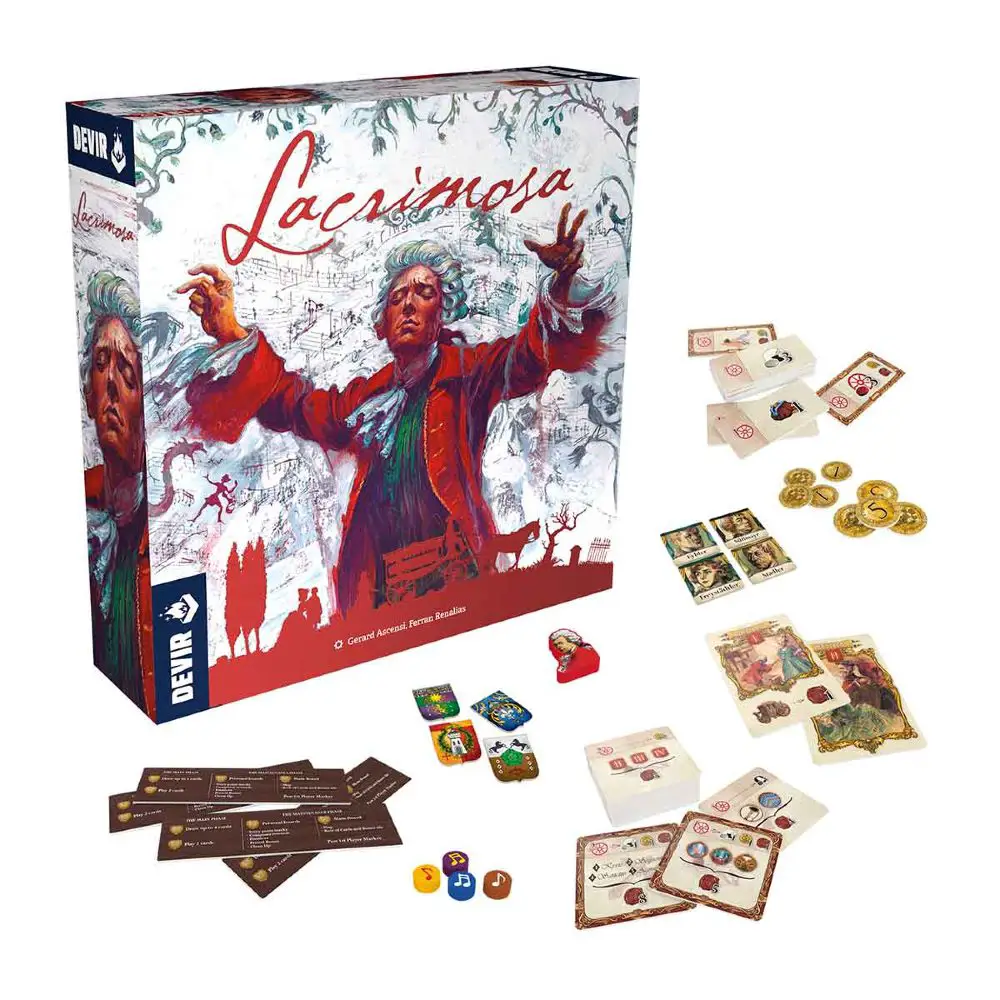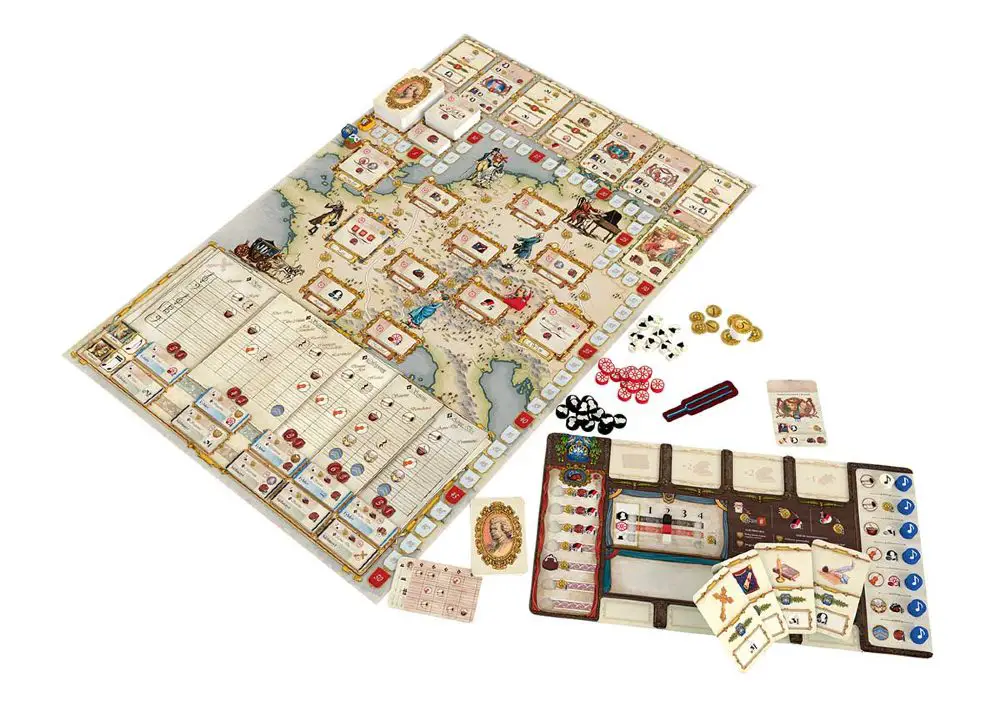Lacrimosa is a board game from Devir with a historic and cultural context: the great composer Wolfgang Amadeus Mozart died of unknown causes in 1791. While on his deathbed he continued to write, working on his Requiem before he passed. The last eight lines of music he ever wrote was called the Lacrimosa. Lacrimosa focuses on what happened after Mozart’s passing.
In the game, players are patrons of Mozart and are tasked by his widow Constanze to help complete the Requiem – and show their importance in the life and journey of Mozart. The concept complexity carries on into the complexity of setting up and playing the game. While it’s filled with facts about the world of Mozart, novice players will be left with questions in the process.
What’s In The Box?
Lacrimosa is a hefty board game and comes with:
- the main board
- 4 player boards
- 4 game summar tiles
- a first player marker
- 4 scoring shield tokens
- money (10 five-ducat coins and 20 one-ducat coins)
- 45 story point counters
- a journey’s marker
- 4 generic Requiem markers
- 48 player pieces
- 5 Constanze cards and 10 Constanze counters
- 40 starting cards
- 4 composer portrait tiles
- 11 soloist cards
- 4 composer portrait tiles
- 11 Soloist cards for Solitaire
- 60 composer tiles
- 15 city tiles
- 34 memory cards
- 46 Opus cards
- 15 period Bonus tiles
- 16 Royal Court tiles
- and, of course, a rulebook

How’s It Play?
Each player has their own personal board that corresponds to a different royal court. On their board, players insert a pair of memory cards during each turn, following one of five actions printed on the card. The actions are document memories, commission and opus, perform/sell music, travel, or add to the Requiem. The game is divided into five rounds that represent different time periods of Mozart’s life and each movement involves four turns. The goal of the game is to get as many victory points as possible.
It’s difficult to fully explain how to play this game because there are so many moving parts. Organizing the box contents and setting up the main board feel like their own separate steps because of how time consuming it is. When I opened the game (which is a hefty 8 pounds!!!), I had to take the time to punch out all of the individual tiles from the sheets they were printed on. With the exception of the Solitaire and Constanze cards, every card has the same backing. To avoid confusion I separated the starting cards, memory cards, and opus cards from each other. It took me 45 minutes just to get the game organized in a way that made sense. After this, it took another 50 minutes to set up the game for the first time. The board is huge and took up a large portion of the table space I had available.

When I taught my friends how to play the game, it took a solid 15 minutes. This was after spending 25 minutes setting up the board. With each turn, players choose one card to use for an action and one card to use for the story. The story cards give points that can be used for actions in the next round. For example: to move Mozart across the board, journey tokens are needed. A player could gather three journey tokens which would give them more options when they used a travel action in the following round. All five actions come with multiple parts, which makes learning the game hard. The instruction manual ended up being passed around the table during each turn so the players could understand what their options were and what could be done.
One cool thing about the game is the solitaire option. There’s a deck specifically for solitaire mode, which leaves the player juggling two personal boards along with their personal deck. The soloist doesn’t have as many rules as the player does – the focus is simply on the action of the cards drawn, not the strategy of gaining story points. It takes a bit of practice but like the main game, after a round or so it goes smoothly. I played solitaire mode before I played with other people, and because the instruction manual didn’t have to move from person to person, I had a much more enjoyable experience. It was calming but still required a bit of strategy. However, trying to move pieces between two boards was tricky.
I had expected to learn more from a game about Mozart. Instead, I got a lot of trivia bits. Did you know that Mozart at one point traveled to Frankfurt and at another point Wien? Did you know that two pieces of music by Mozart are the Symphony 36 and the Vesperae solennes de confessore? It’s cool that music cards have the year that they were written printed on the card, but as someone who doesn’t know classic music it meant very little to me.
This game was published in five languages: English, Spanish, Portuguese, Italian and Catalan. Because of this, the game is mostly picture based. All print on the board, cards, and tiles are numbers, proper names, or Latin phrases. The exception to this are the game summary tiles which are written in the language that the player is using. It’s an interesting way to make the game more accessible, but that also makes the game a little harder to play.
Verdict
Lacrimosa is a game full of potential. It’s a long game with a lot of rules, but when I played it I understood why someone could fall in love with it. The most difficult part was the set up, but understanding the board, card, and tile instructions were confusing simply because it was all image based. It’s an absolutely gorgeous game with artwork that fits the styles of the 1700s. It’s heavy because of how sturdy the cards and tiles are. It’s a 1-4 player game and enjoyable as both a solitaire game and a group game.
Lacrimosa is not a game for a casual board game player because of its complexity, but if one was playing with a group of people who knew what the journey cards meant, it could move more smoothly and enjoyably. It’s the type of game that I’d really want to learn because even though I never played a full game, I had fun with how far I got.
Lacrimosa can be picked up from Devir Games for $79.99.
Images and Review Copy Courtesy of Devir
Have strong thoughts about this piece you need to share? Or maybe there’s something else on your mind you’re wanting to talk about with fellow Fandomentals? Head on over to our Community server to join in the conversation!

